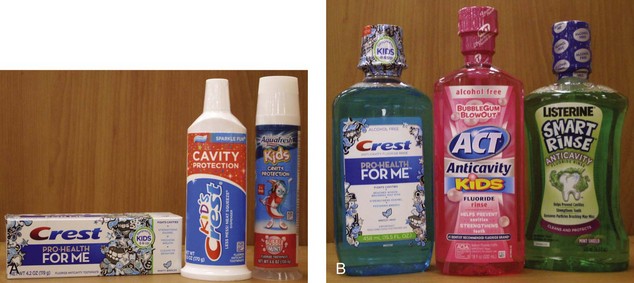Prevention of Dental Disease
Fluoride Administration
Systemic Fluorides
Studies suggest that a substantial portion of the anticaries protection provided by water fluoridation in humans occurs during the preeruptive period.1,2 Additional studies in laboratory animals have reported that daily doses of fluoride administered via gastric intubation during the period of tooth formation reduced the incidence of caries in these teeth after eruption.3 Because systemically acquired fluoride may be deposited and redistributed in developing teeth during the mineralization phase as well as during the subsequent period before eruption, current recommendations call for systemic fluoride supplements for children at high risk of developing caries and residing in areas where the water is fluoride deficient until they reach the age of 16 years.4 This protocol should help to ensure maximum protection for the posterior teeth, which are more vulnerable to carious attack. Supplemental fluoride dosages remain constant for children between the ages of 6 and 16 years.
Topical Fluorides
Accumulating evidence continues to support the effectiveness and importance of frequent application of agents that contain relatively low concentrations of fluoride. The two principal forms of these agents in the United States are fluoride toothpastes and fluoride mouth rinses (Figure 31-1).
Fluoride Toothpastes
The twice daily use of a fluoride-containing dentifrice should form the foundation of the child’s preventive dental activities. To maximize the effect of fluoridated toothpaste, rinsing after brushing should be kept to a minimum or eliminated altogether.5 Although many toothpastes include fluoride in their formulations, products that have obtained approval by the Council on Dental Therapeutics of the American Dental Association (ADA) should be recommended. Formulations of toothpastes that have not obtained ADA approval may impede the release of fluoride from these products, thereby compromising their effectiveness.5 Currently, approved fluoride toothpastes contain sodium fluoride (NaF) or sodium monofluorophosphate (MFP) as active ingredients. In the United States, the maximal allowable concentration of fluoride in toothpastes that have not received New Drug Approval from the Food and Drug Administration is 1100 parts per million (ppm).6 Parents should be advised that some over-the-counter products contain higher fluoride concentrations (e.g., 1500 ppm).
Fluoride Mouth Rinses
Numerous clinical trials conducted in the 1960s and 1970s reported caries reductions in the 20% and 40% range among children in nonfluoridated areas who rinsed either weekly with a 0.2% NaF rinse or daily with a 0.05% NaF product.5 More recent studies, conducted since the overall decline in dental caries in children became evident, have reported that (1) the expected benefits from fluoride rinsing in terms of the actual number of tooth surfaces saved from becoming carious are generally less than previously reported, and (2) rinsing appears to have a greater effect in older children (10 years of age).5 Nevertheless, the observation that fluoride rinsing provides greater protection to erupting teeth during the time when rinses are being applied provides a rationale for their use in some 6- to 12-year-old age groups.
Concentrated Agents for Professional Application or Home Use
Applications of more concentrated forms of fluoride should be considered for persons who are at elevated risk for dental caries, including those who cannot or do not make optimal use of the high-frequency, low-concentration forms of fluoride therapy. Generally, this implies semiannual applications of concentrated fluoride gels or forms in the dental office. Fluoride varnish applications have also been suggested for Acidulated phosphate fluoride [high-risk patients (see Chapter 14).
Several fluoride gels and solutions, including combinations of acidulated phosphate fluoride (APF) and stannous fluoride, are available for home use. Practitioners should be aware that some of these products contain concentrations of fluoride that are similar to those found in fluoride toothpastes or over-the-counter rinses, and in most cases they have not undergone clinical testing. Some of these low-concentration products have also been advocated for professional application, but they are unlikely to be effective when used infrequently.7 Therefore the advantage of these less concentrated products over commercially available fluoride toothpastes and mouth rinses is questionable. More concentrated fluoride gels (0.5% acidulated phosphate fluoride [APF]) have been shown to be effective in reducing the incidence of caries and may be useful in high-risk patients with rampant caries.
Stay updated, free dental videos. Join our Telegram channel

VIDEdental - Online dental courses


 Outline
Outline
 FIGURE 31-1
FIGURE 31-1